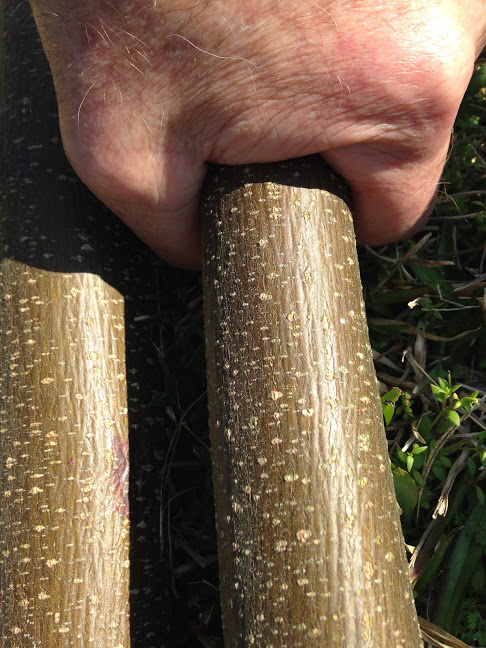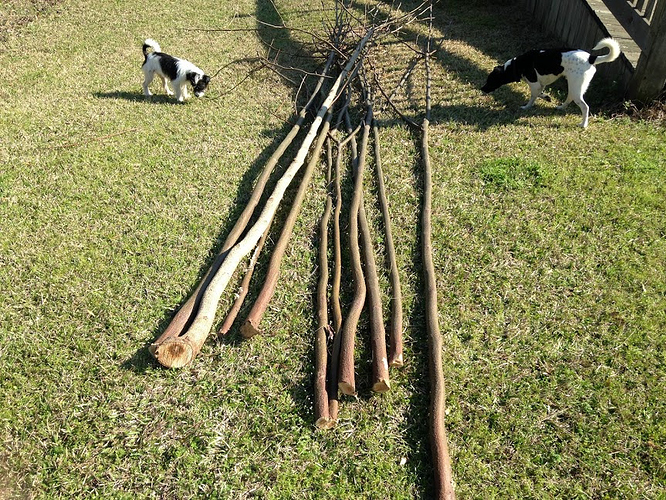And yet we were only 8 million and 17 people per km2 at that time. Woodgas is not for everyone. Nothing is really 
No, I fear we are in classic population overshoot, in some relatively short period of time we will start to see a sharp correction. But given how tenacious and clever we are as a species, I wonder how much of the rest of life on earth we may bring down before that.
Wood gas is an alternative energy source among others.
It is up to us to manage it in a sustainable way.
We who live close to the forest, use the, this our asset:slight_smile:
You got that right the future of energy isn’t a one source world. Time to use what is local to best meet your current and future needs.
Anybody know what kind of wood this might be, here in Arkansas? The stump in my yard keeps sprouting. This is 2 years old. Looks like good gasifier fuel, long, straight, and very few limbs.
It looks like same thing we have here, ours is sycamore. Grows fast, sprouts from stumps, and starts from seed pods from mature trees. I hope it makes good fuel I just chunked about 300 lbs of it.
Looks like Tree of Heaven: https://www.extension.iastate.edu/forestry/iowa_trees/trees/tree_of_heaven.html
Hey Carl,
I don’t know the proper name but if they had been here today we could call them chunked gasifier fuel 
did Mr. Dolittle’s buddies come for a visit?
Tree of heaven will go punky real fast out in the open
In my yard, it is called “box elder”. I use it when available, but it doesn’t give me good mileage Caught young, it is easy to chunk in my chunker TomC
I like how you’re dual feeding that chunker. If that feeder tube up on top was rectangular, I believe it would be fighting those wood turning actions as the wood worked it’s way down.
I was thinking box elder too.
Doesn’t look like the box elder I know, bark isn’t right, and the growth habit seems too vigorous and upright.
If Chris is correct, be careful and wear gloves.
So glad that won’t grow here. Some of these alien tree and shrub species are going to be a real disaster in a century or two. Amazing nobody regulated the decorative plant trade when they had the chance.
Apparently it is chinese sumac and there are several varieties of it. It is also mildly poisonous and will prevent plants from growing around it.
Here is the a bunch of info including several ways to identify it and control it. but it doesn’t include the toxicity.
Well if it is anything like the suemack that is here good luck getting rid of it!!! That stuff has been taking over around here my entire life and is a constant battle to try to keep beat back. Nasty stuff it grows off the smallest part of a root left in the ground. As much as I hate chemicals I think I might have to go for a round of chemical warfare on suemack this summer.
Try watering it with condensate
Works as well as roundup and leaves a nice black stain so you know where you treated
I’m pretty sure it’s Sumac. Grows wild here. I have seen it in Indiana, Michigan, Wisconsin, and Minnesota. My Uncle used to dig it up and replant it around his yard and flower beds account of the different brilliant colors it turns in the fall months.
The native sumac reaches as far as southern Manitoba, and is a mild and highly decorative species with its somewhat palm like appearance, and firey red fall foliage and velvety berries . I understand that further south some species can be serious skin irritants, which isn’t surprising, given that so called poison ivy is related. (We are blessed with poison ivy here, the northern limit of it’s range)… btw, the southern limit is in central highland Mexico, the vining kind goes further south yet, liking warmer country. Finding the low type in the highlands made me pretty nostalgic 




